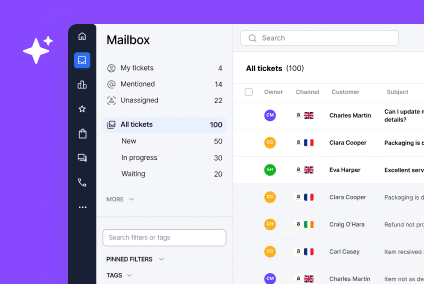Se sei coinvolto nella gestione di un’azienda, saprai già quanto sia importante implementare soluzioni aziendali costruite appositamente per le grandi organizzazioni. Le esigenze delle aziende sono uniche e richiedono un approccio specializzato.
Ma quali sono le dimensioni di un’azienda che viene considerata un’impresa?
Le imprese sono definite come grandi organizzazioni che impiegano centinaia o migliaia di dipendenti e che gestiscono un elevato volume di transazioni commerciali, sia che si tratti di vendite di prodotti che di servizi. Spesso queste aziende sono grandi multinazionali con diversi uffici in tutto il mondo.
A causa delle loro dimensioni e del loro impatto, le imprese sono diverse dalle piccole e medie imprese per quanto riguarda la portata, la scala e le esigenze.
Di conseguenza, gli strumenti e i servizi che le imprese utilizzano per svolgere le loro attività quotidiane sono stati progettati tenendo conto di questo tipo di attività.
In genere, un’azienda richiede soluzioni potenti e che possano essere implementate su larga scala.
Un nuovo anno: Una nuova opportunità per valutare la tua attuale soluzione per l’e-commerce
Molte aziende utilizzano naturalmente il quarto trimestre per riflettere sull’anno trascorso e per cercare di apportare cambiamenti strategici in vista del nuovo anno solare o finanziario.
Una di queste aree di controllo, se sei un’azienda, è probabilmente la tua soluzione di ecommerce.
In particolare, dovrai valutare se la tua attuale soluzione di ecommerce è in grado di gestire contemporaneamente tutte le complesse attività legate alla tua attività, come ad esempio:
- La capacità di gestire più categorie di prodotti in più sedi
- Integrazioni con i sistemi di contabilità e di gestione delle relazioni con i clienti (CRM)
- Se offre raccomandazioni ai clienti basate su una potente tecnologia AI
- Il potenziale di scalare con l’aumento del traffico dei clienti
Quando si valutano le esigenze future della tua azienda, è fondamentale prestare particolare attenzione alle tendenze in atto e una di queste è l’enorme aumento delle transazioni online, sia B2B che B2C.
Le previsioni indicano un continuo aumento degli acquisti online fino al 2025. Se vendi ai consumatori, potresti già notare un aumento del numero di transazioni giornaliere che gestisci.
Allo stesso modo, se vendi un prodotto o un servizio ad altre aziende, potresti assistere a una crescita delle vendite online nella nostra economia sempre più digitale.
Per questo motivo, molte aziende hanno bisogno di una soluzione di ecommerce costruita appositamente per soddisfare queste crescenti esigenze di ecommerce.
Dato che l’ecommerce sta diventando un aspetto sempre più importante per tutti i tipi di aziende, potresti pensare che sia il momento giusto per la tua attività di passare a una piattaforma ecommerce aziendale.
La scelta della giusta piattaforma ecommerce aziendale è essenziale per garantire il buon funzionamento delle vendite online della tua azienda, compresi punti di contatto cruciali come l’evasione dei prodotti e il servizio clienti.
Perché la tua azienda ha bisogno di un software di e-commerce ad hoc
Se la tua azienda è cresciuta di recente, potrebbe essere il momento di aggiornare la tua soluzione ecommerce. Quello che funzionava per la tua azienda quando era più piccola potrebbe non essere più adatto alla tua crescita.
O forse non hai ancora trovato una soluzione ecommerce adatta alle tue esigenze.
In ogni caso, è importante capire quali sono i diversi tipi di soluzioni software per l’ecommerce, cosa offrono e come possono aiutare la tua azienda.
L’utilizzo di un software di ecommerce creato appositamente per le aziende significa che il modo in cui il software è stato progettato è basato sulla comprensione del funzionamento delle aziende e di ciò che è necessario per soddisfare le esigenze di un’azienda globale.
Pertanto, un software di ecommerce esplicitamente progettato per le aziende può offrire alcuni vantaggi sostanziali, tra cui:
- Miglioramento del coinvolgimento nelle vendite
- Funzionalità multi-sito
- Migliore consapevolezza del marchio
- Razionalizzazione ed efficienza
Capire i diversi tipi di software per l’e-commerce
Ci sono molti marchi diversi sul mercato che offrono soluzioni di ecommerce, ma le piattaforme differiscono leggermente l’una dall’altra. Per questo motivo, è utile conoscere i diversi tipi di piattaforma in modo da trovare la soluzione più adatta alle tue esigenze specifiche.
On-site. Con una soluzione ecommerce on-site, significa che il software viene memorizzato sul server locale della tua azienda. Poiché i dati sono archiviati localmente, spesso può offrire velocità, sicurezza e scalabilità superiori a quelle di un’applicazione web.
Basato su cloud/SaaS. Un software basato sul cloud significa che il software è ospitato sul web e “venduto come servizio” (SaaS). Ciò significa che la tua azienda non ospiterà il software sui propri server, ma accederà al software tramite una soluzione online ospitata nel cloud.
Il vantaggio è che non dovrai investire in server fisici (hardware) su cui ospitare il software perché l’intera soluzione, compresi storage, database e funzionalità di rete, è accessibile tramite un modello di abbonamento basato sul cloud.
Open-Source. Il software open-source è un tipo di software che ha un codice sorgente completamente trasparente che può essere sviluppato da te. Si tratta di un tipo di software molto collaborativo che ti sarà utile se vuoi costruire la tua soluzione di ecommerce aziendale ma vuoi una “base” da cui partire.
Le soluzioni open-source ti permettono di personalizzare la tua piattaforma di ecommerce, ma per farlo avrai bisogno di sviluppatori esperti; non si tratta di una tipica soluzione “plug and play”.
Vale anche la pena di notare che alcune di queste tipologie si sovrappongono. Ad esempio, un servizio SaaS basato sul cloud potrebbe essere anche open-source. Ogni tipo di servizio presenta dei vantaggi, quindi capire quali sono i diversi tipi e come funzionano per le tue esigenze aziendali ti aiuterà a trovare il tipo di servizio più adatto a te e alla tua azienda.

Scegliere la piattaforma e-commerce giusta per il tuo tipo di impresa
Abbiamo già detto perché è fondamentale scegliere la piattaforma più adatta alla tua attività. Per approfondire ulteriormente la ricerca della soluzione perfetta, considera il tuo tipo di azienda per scegliere il software più adatto.
Chiarire e comprendere il tuo pubblico ti permette di individuare con precisione ciò che ti serve da una piattaforma ecommerce aziendale.
Ad esempio, sei un’azienda business-to-business (B2B)? Oppure sei un’azienda B2C (business-to-consumer)? O forse la tua attività è meglio descritta come DTC (direct-to-consumer)? Se hai ben chiaro a chi stai vendendo, potrai scegliere il tipo di software più adatto alle tue esigenze.
Se sei un’azienda B2B, la soluzione migliore è quella basata sul cloud, perché è più agile e offre una grande quantità di dati da memorizzare. Tuttavia, se la tua azienda dispone di un team di esperti di programmazione, potresti desiderare che il software sia open-source, in modo da poterlo migliorare e creare soluzioni più personalizzate.
D’altra parte, se sei un’azienda B2C che detiene molti dati sensibili di singoli clienti, puoi scegliere una soluzione on-site. Tutti i dati saranno archiviati localmente su un server fisico e non passeranno attraverso un server basato sul cloud. Ciò significa che i dati possono essere archiviati in modo più sicuro, in conformità con i requisiti normativi.
Individuare il tipo di azienda e le esigenze dei tuoi clienti ti aiuterà ad avere la giusta conversazione con i fornitori di software quando dovrai valutare la piattaforma ecommerce da scegliere.
Quindi, quali sono le tue opzioni?
Le 7 migliori piattaforme di e-commerce aziendali per il 2025
Con l’avvicinarsi del nuovo anno, è un’ottima occasione per passare a una nuova piattaforma ecommerce aziendale.
Quando si tratta di esaminare le specifiche piattaforme di ecommerce aziendale disponibili sul mercato, abbiamo stilato un elenco dei contendenti, includendo i pro e i contro di ciascuno.
1. Magento Enterprise

Di proprietà di Adobe, una nota e affidabile azienda di software, Magento è una piattaforma di ecommerce aziendale open-source e self-hosted. Essendo open-source, offre alla tua azienda la flessibilità e il potere di creare una soluzione ecommerce precisa e adatta alla tua attività.
Sebbene Magento non offra un team di assistenza clienti, vanta comunque un’ampia comunità di sviluppatori di ecommerce che può aiutarti a risolvere qualsiasi domanda o problema.
Gli svantaggi dell’utilizzo di Magento sono che devi acquistare il tuo hosting, i certificati di sicurezza e il nome del dominio, cosa che spesso è inclusa in altre piattaforme di ecommerce aziendali. Inoltre, ogni paio d’anni Magento aggiorna il suo software, e gestire questi aggiornamenti può essere costoso e dispendioso in termini di tempo.
2. Salesforce Commerce Cloud

Se possiedi più di cinque negozi online, Salesforce Commerce Cloud potrebbe essere la soluzione giusta, in quanto considera coloro che hanno cinque o più negozi online come utenti aziendali e si rivolge a loro con la sua piattaforma di livello enterprise.
Oltre a gestire le transazioni di e-commerce, Salesforce offre anche un punto vendita (POS) mobile-first all’interno della sua piattaforma. In questo modo, è anche in grado di fornire un supporto di prim’ordine alla vendita omnichannel. Questo include la fornitura di approfondimenti sui clienti basati sui dati per aiutarti a personalizzare meglio i tuoi consigli per gli acquisti.
Salesforce Commerce Cloud è una soluzione utile anche per le aziende che vendono a livello internazionale, in quanto è in grado di gestire più negozi all’interno di un’unica soluzione backend che tratta numerose valute e supporta numerose lingue. Offre un’assistenza clienti 24 ore su 24, 7 giorni su 7 e si integra perfettamente con altri prodotti Salesforce, tra cui il suo noto e ampiamente adottato CRM.
Gli svantaggi di Salesforce Commerce Cloud includono la necessità di conoscenze tecniche. Non si tratta di un prodotto “plug and play” per chi non ha competenze tecniche. Poiché i prezzi si basano sulla percentuale di vendite, Salesforce può anche essere una soluzione più costosa.
3. BigCommerce Impresa

Sebbene BigCommerce non preveda pacchetti tariffari specifici per le aziende, offre un utile supporto agli utenti aziendali. Questo include filtri personalizzati, sviluppo di staging, integrazione con diversi gateway di pagamento e supporto per il commercio multicanale.
È in grado di gestire grandi picchi di traffico (utile durante i periodi di shopping natalizio), supporta le aziende B2C e B2B con soluzioni personalizzate e dispone di una vasta gamma di Integrazioni con diversi sistemi CRM ed ERP.
Tuttavia, il suo modello di prezzo si basa sul volume delle vendite, il che rappresenta uno svantaggio per le aziende che vogliono scalare, perché il prezzo aumenterà con l’aumentare delle transazioni.
4. Shopify Plus

Shopify Plus è una soluzione solida sia per le piccole imprese che per le aziende. È completamente in hosting, il che significa che le questioni tecniche come il codice, la sicurezza e la larghezza di banda sono tutte gestite direttamente. È una soluzione conveniente con un servizio clienti attivo 24 ore su 24, 7 giorni su 7, e avrai a disposizione un account manager dedicato.
Shopify Plus è in grado di gestire ben oltre 10.000 transazioni al minuto, assicurando che anche la stagione delle vendite natalizie si svolga senza problemi. Inoltre, offre oltre 1.500 plug-in che possono integrarsi con il tuo sito web per risolvere problemi che vanno dal marketing al servizio clienti.
Il costo dei plug-in può però aumentare. Più funzioni premium aggiungi, più il prezzo diventa alto. Questo è in contrasto con i concorrenti che offrono funzioni aggiuntive con un unico prezzo. Inoltre, il codice di Shopify non si presta alla personalizzazione. Quindi, se desideri un design personalizzato, potresti non essere in grado di realizzarlo.
Correlato: Scopri di più sull’integrazione di Shopify di eDesk
5. OpenCart

OpenCart è una piattaforma di ecommerce aziendale open-source con un’interfaccia intuitiva e piuttosto facile da usare. Supporta molto bene le aziende offrendo prodotti illimitati, supportando più valute e metodi di spedizione e oltre 20 gateway di pagamento.
Essendo facile da usare, OpenCart è un’opzione eccellente per i principianti. Tuttavia, questo significa anche che OpenCart non è particolarmente adattabile alla personalizzazione, quindi se decidi di personalizzarlo, la tua azienda potrebbe dover sostenere costi aggiuntivi per coinvolgere uno sviluppatore PHP dedicato.
In termini di costi, OpenCart è gratuito, ma richiede costi aggiuntivi per l’hosting, il dominio e le estensioni web o i plug-in, che si sommano.
6. Oracle CX Commerce

Oracle CX Commerce, precedentemente noto come Oracle Commerce Cloud, è un attore di peso nello spazio aziendale. Quando si parla di piattaforme di e-commerce aziendali, Oracle CX Commerce offre una potente suite di prodotti e servizi.
A partire da 150.000 dollari, ha un prezzo elevato, ma in cambio otterrai un supporto completo per tutto ciò che riguarda le tue esigenze di e-commerce, tra cui la contabilità, le spedizioni, la gestione di più negozi, l’elaborazione degli ordini e molto altro ancora. Ha puntato molto sulla sua esperienza mobile, quindi lavorerà duramente per ottimizzare il tuo negozio per gli acquirenti mobili. Inoltre si presta bene alla scalabilità, crescendo insieme alla tua attività.
Sebbene sia sicuramente potente, gli svantaggi dell’utilizzo di Oracle CX Commerce includono il fatto che non supporta il checkout con un solo clic e non si integra con i mercati online come Walmart Marketplace, Amazon o eBay. Detto questo, si integra con prodotti diversi dalla sua suite, il che lo rende una scelta versatile per le aziende che vogliono scalare rapidamente.
7. Adobe Commerce Cloud

Adobe Commerce Cloud si integra pienamente con tutti gli altri strumenti aziendali di Adobe, il che è utile se utilizzi già i prodotti Adobe in altre aree della tua azienda. Tra le caratteristiche degne di nota vi è la possibilità di implementare modelli ibridi di ecommerce B2B e B2C, gestire più siti e marchi e creare applicazioni web.
Adobe Commerce Cloud ha integrato Magento nella sua piattaforma di ecommerce aziendale, rendendola compatibile con le estensioni Magento e quindi altamente personalizzabile.
Inoltre, offre una capacità di raccolta dati proprietaria che aiuta la tua azienda a fidelizzare i clienti e ad aumentare le vendite.
Tuttavia, può essere difficile da usare per i nuovi utenti che non hanno già familiarità con i prodotti Adobe. Se non hai dimestichezza con la personalizzazione delle piattaforme di ecommerce, la curva di apprendimento può essere molto ripida. Poiché il prezzo si calcola in base al numero di posti (come per gli altri prodotti Adobe), Adobe Commerce Cloud può essere costoso per le aziende con numerosi membri del team che lavorano nel negozio.
Pensieri finali
Fai in modo che il 2025 sia l’anno migliore per risolvere i problemi dell’ecommerce aziendale
Tutte le piattaforme ecommerce aziendali di cui sopra offrono buone soluzioni se sei un’azienda che vuole aggiornare la propria piattaforma ecommerce nel 2025 e oltre.
Sebbene la decisione di acquistare e implementare una nuova piattaforma di ecommerce non debba essere presa alla leggera, fortunatamente è chiaro che le aziende hanno l’imbarazzo della scelta quando si tratta di trovare il giusto fornitore di software.
Prendendoti il tempo necessario per capire le esigenze della tua piattaforma ecommerce e confrontandole con le varie offerte di queste migliori piattaforme ecommerce aziendali, sarai sulla buona strada per prendere la decisione giusta per la tua azienda nel prossimo anno.
eDesk è stato creato appositamente per le aziende di e-commerce. Richiedi una demo per saperne di più su come eDesk può migliorare il tuo servizio clienti nel 2025.




